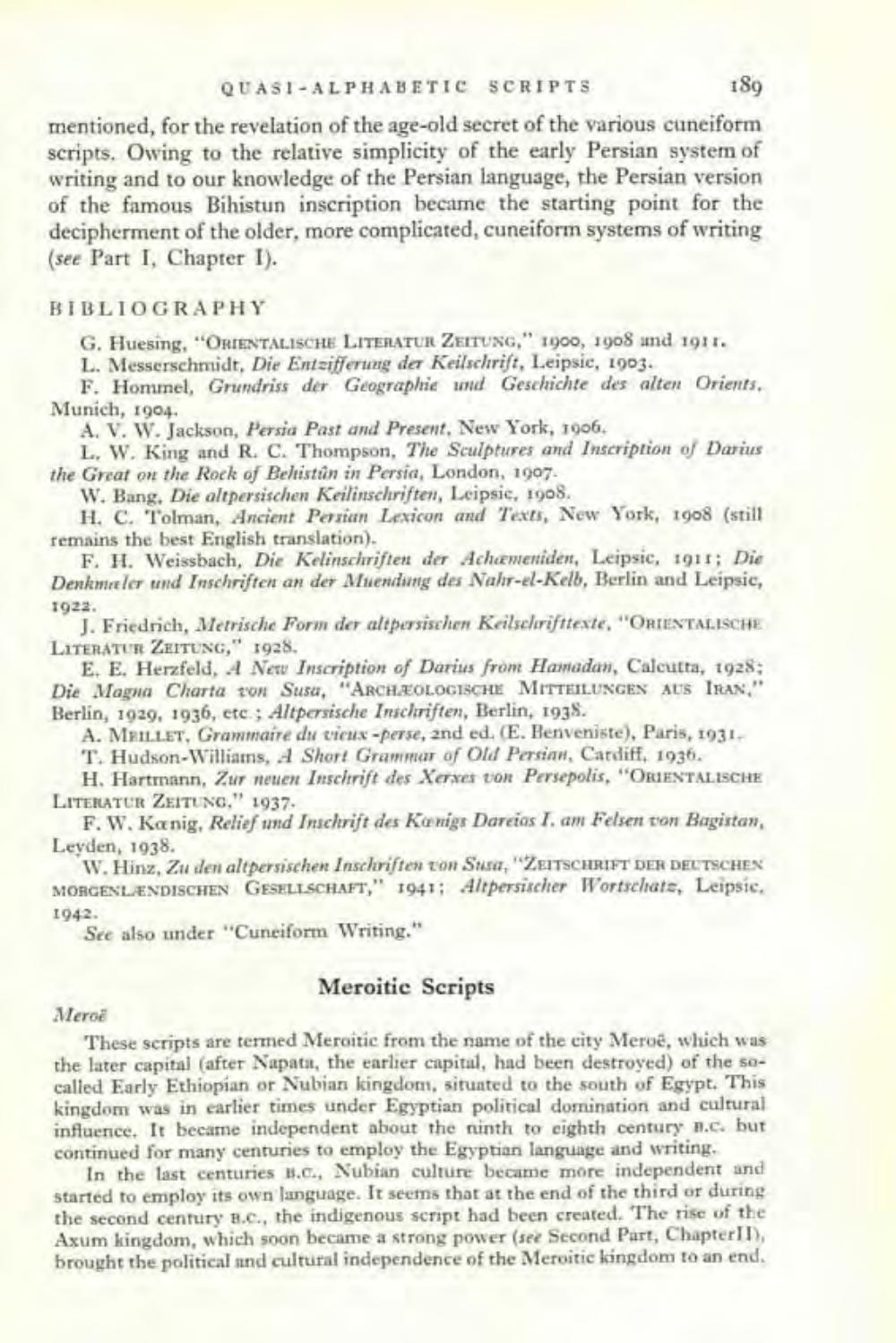________________
QUASI- ALPHABETIC SCRIPTS
189 mentioned, for the revelation of the age-old secret of the various cuneiform scripts, Owing to the relative simplicity of the early Persian system of writing and to our knowledge of the Persian language, the Persian version of the famous Bihistun inscription became the starting point for the decipherment of the older, more complicated, cuneiform systems of writing (see Part 1, Chapter I).
BIBLIOGRAPHY
G. Huesing, "ORIENTALISCHE LITERATUR ZEITUNG," 1900, 1908 und 1911. L. Messerschmidt, Die Entzifferung der Keilsclirilt, Leipsie, 1903.
F. Hommel, Grundriss der Geographie und Geschichte des alten Orients, Munich, 1904
A. V. W. Jackson, Persia Past and Present, New York, 1906.
L, W. King and R. C. Thompson, The Sculptures and Inscription of Darius the Great on the Rock of Delistûn in Persia, London, 1907
W. Bang. Die altpersischen Keilinschriften, Leipsie, 1908.
H. C. Tolman, Ancient Persian Lexicon and Texts, New York, 1908 (still remains the best English translation).
F. H. Weissbach, Die Kelinschriften der Achemteniden, Leipsie, 1911; Die Denkmreler und Inschriften an der Mueniung des Nahr-el-Kelb, Berlin and Leipsic, T922.
J. Friedrich, Metrische Form der altpersischen Keilsclorifttexte, "ORIENTALISCHE LITERATUR ZEITUNG," 1928.
E. E. Herzfeld, A New Inscription of Darius from Hamadan, Calcutta, 1928; Die Magna Charta zon Susu, "ARCHÆOLOGISCHE MITTEILUNGEN AUS IRAN," Berlin, 1929, 1936, cte; Altpersische Inschriften, Berlin, 1938.
A. MEILLET, Grammaire du vieux-perse, and ed. (E. Benveniste), Paris, 1931. T. Hudson-Williams, Short Grammar of Old Persian, Cardiff, 1936.
H. Hartmann, Zur neuen Inschrift des Xerxes vor Persepolis, "ORIENTALISCHE LITERATUR ZEITUNG," 1937,
F.W. Kanig, Relief und Inschrift des Kunigs Dareias I. am Felsen ton Bagistan, Leyden, 1938.
W. Hinz, Zu den altpersischen Inschriften ton Susa,ZEITSCHRIFT DER DEUTSCHEN MORGENLENDISCHEN GESELLSCHAFT," 1941; Altpersischer Wortschats, Leipsie. 1942.
See also under "Cuneiform Writing."
Meroitie Scripts Merci
These scripts are termed Merotic from the name of the city Meroe, which was the later capital (after Napata, the earlier capital, had been destroyed) of the socalled Early Ethiopian or Nubian kingdom, situated to the south of Egypt. This kingdom was in earlier times under Egyptian political domination and cultural influence. It became independent about the ninth to eighth century a.c. but continued for many centuries to employ the Egyptian language and writing.
In the last centuries B.C, Nubian culture became more independent and started to employ its own language. It seems that at the end of the third or during the second century s.c., the indigenous script had been created. The rise of the Axum kingdom, which soon became a strong power (sex Second Part, Chapter !), brought the political and cultural independence of the Merotic kingdom to an end.




